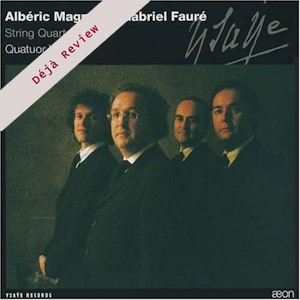
Déjà Review: this review was first published in March 2005 and the recording is still available.
Albéric Magnard (1865-1914)
String Quartet in E minor Op.16 (1902/3)
Gabriel Fauré (1845-1924)
String Quartet Op.121 (1923/4)
Quatuor Ysaÿe
rec. 2004, Dortoir des moines, Abbaye de l’Epau, France
Aeon AECD0426 [65]
Who would have thought that Ansermet’s pioneering recording of Magnard’s Third Symphony many years ago would eventually have resulted in a near-complete recording of this composer’s substantial, if small in number, output. There are now three recorded sets of his symphonies (EMI, Hyperion and BIS), a recording of his shorter orchestral works (Timpani), a splendid recording of Guercoeur as well several discs of his chamber music. The only conspicuous gap in Magnard’s present discography is the absence of a recording of his third opera Bérénice. His first opera Yolande will probably remain unperformed and unrecorded since the orchestral parts are now lost, whereas the existing vocal score offers no hints at the orchestration. This must be the third recording of his masterly String Quartet in E minor Op.16, if my memory serves me right. It would be idle to go into any detail about this towering masterpiece, suffice it to say that it is one of Magnard’s most imposing, complex and uncompromising major works. As Harry Halbreich rightly remarks in his indispensable book Albéric Magnard (written with Simon-Pierre Perret, published by Fayard 2001), in which he compares Magnard’s String Quartet with Schönberg’s near-contemporary First String Quartet, Magnard and Schönberg resume string quartet composition from where Beethoven left off with his String Quartet Op.131. Magnard’s quartet may still be much indebted to Franck through the use of cyclic motives, the harmonic tension and the masterly contrapuntal writing it generously displays; but Magnard’s approach is totally individual and highly personal. All movements, but the Serenade placed second and functioning as a Scherzo, are based on intricately worked-out sonata forms. The final movement Danses – Vif, populaire, is a typical Magnard finale, in that it vigorously, though rigorously suggests rustic dances and displays rugged energy that partly dispels the harmonic tension of the preceding movements. This, however, is no folk-like romp, for every minute of it is strictly kept under control. The String Quartet is a grand masterpiece that will never be popular because of its complexity, but it should nevertheless make its mark by sheer expressive strength, powerfully propulsive energy and generous if rugged lyricism.
I have long been prejudiced against Fauré’s music and have neglected it for many years. I have now come to regard it differently; is this the privilege of getting older, I do not know? I was delighted to have this opportunity to renew acquaintance with his late String Quartet Op.121. It is his last major work completed during the twilight of his life, when deafness had isolated him. Significantly, there is nothing morbid about this autumnal masterpiece. Intimations of mortality, maybe, but beaming with some inner joyfulness and full of tranquil recollection. Musical ideas are as fresh as ever, unfolding leisurely, without any sentimentality but with a moving expressiveness as of wisdom gained over the years. But for all its warm lyricism, the music is skilfully worked-out across the three movements, with a remarkable lightness of touch and with as sure a hand as ever.
I have already had the opportunity to enthuse about the Ysaÿe’s immaculate playing and dedicated musicality, whether they play Boucourechliev, Magnard or Fauré. These qualities also serve these substantial works well. I enjoyed this splendid release enormously. Not to be missed.
Hubert Culot
Help us financially by purchasing from



















